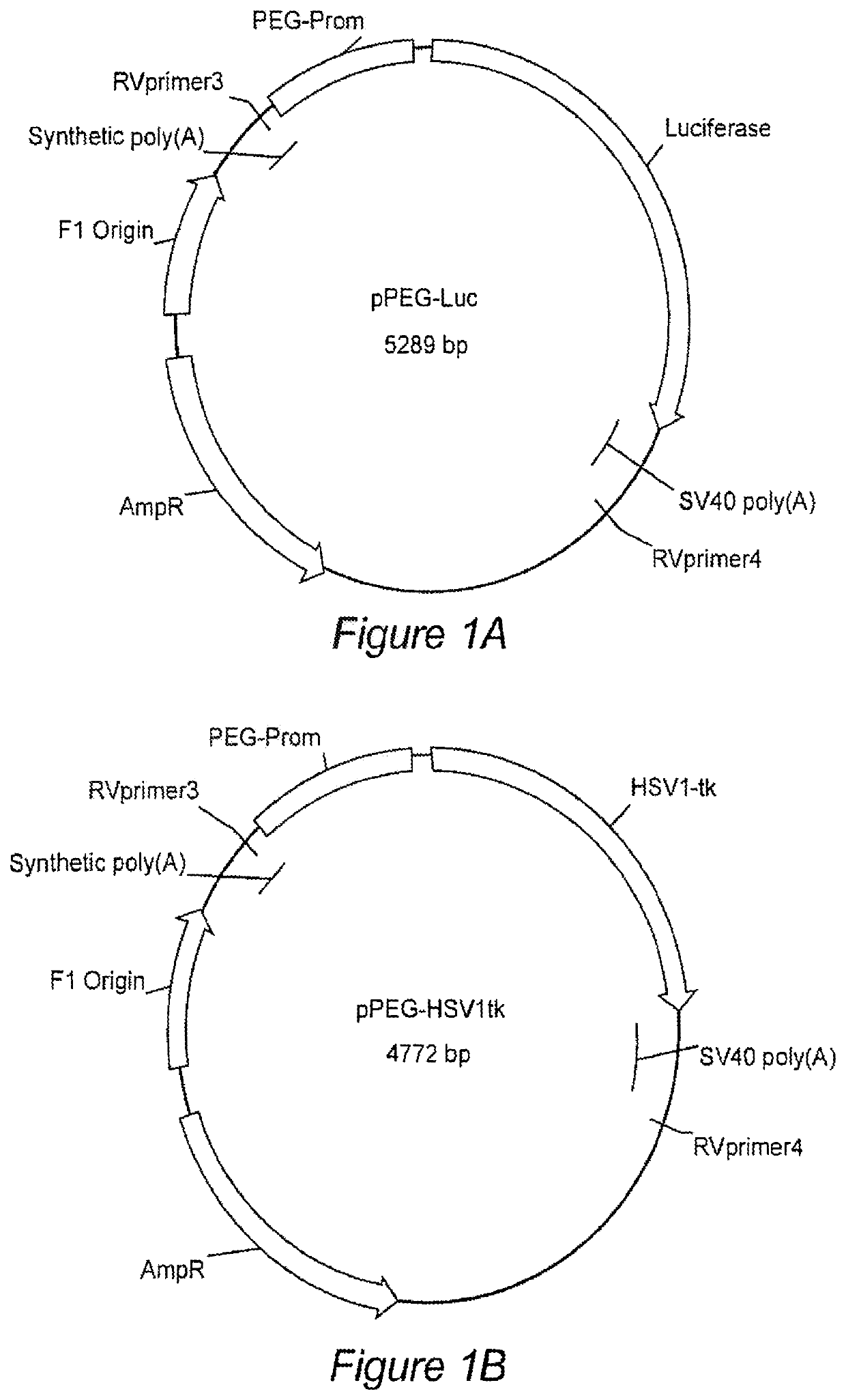Cancer imaging with therapy: theranostics
a technology of cancer imaging and theranostics, applied in the field of genetic constructs, can solve the problems of unacceptably high background noise, unsatisfactory specific localization of imaging agents, and none of these techniques have provided sufficient specific localization of imaging agents, and achieves a high level of precise delivery of anti-tumor agents, low background noise, and low cost.
- Summary
- Abstract
- Description
- Claims
- Application Information
AI Technical Summary
Benefits of technology
Problems solved by technology
Method used
Image
Examples
example 1
References for Example 1
[0101]1. Blasberg, R. G. & Tjuvajev, J. G. Molecular-genetic imaging current and future perspectives. J Clin Invest 111, 1620-1629 (2003).
[0102]2. Zhang, Y., et al. ABCG2 / BCRP expression modulates D-Lucilerin based bioluminescence imaging. Cancer Res 67, 9389-9397 (2007).
[0103]3. Uhrbom, L., Nerio, E. & Holland, E. C. Dissecting tumor maintenance requirements using bioluminescence imaging of cell proliferation in a mouse glioma model. Nat Med 10, 1257-1260 (2004).
[0104]4. Kishimow, H., et al. In vivo imaging of lymph node metastasis with telomerase-specific replication-selective adenovirus. Nat Med 12, 1213-1219 (2006).
[0105]5. Padmanahhan, P., et al. Visualization of telomerase reverse transcriptase (hTERT) promoter activity using a trimodality fusion reporter construct. J Nucl Med 47, 270-277 (2006).
[0106]6. Freytag, S. O., et al. Phase I trial of replication-competent adenovirus-mediated suicide gene therapy combined with IMRT for prostate cancer. Mol Ther...
example 2
Overview:
[0139]Targeted imaging of cancer remains a significant but elusive goal. Such imaging could provide early diagnosis, aid in treatment planning and profoundly benefit therapeutic monitoring. We identified the minimal promoter region of progression elevated gene-3 (PEG-Prom)1,2 derived from a rodent PEG-3 gene through subtraction hybridization', whose expression directly correlates with malignant transformation and tumor progression in rodent tumors3,4, as well as in human tumors, including cancer cell lines derived from tumors in the brain, prostate, breast, melanoma, and pancreas5-9. Based on these findings, we hypothesized and subsequently confirmed that systemic delivery of the PEG-Prom linked to and regulating an imaging construct would enable tumor-specific expression of reporter genes, not only within a primary tumor, but also in associated metastases in a manner broadly applicable to tumors of different tissue origin or subtype10. PEG-Prom is responsive directly to el...
example 3
References for Example 3
[0171]1. Bhang H-eC, Gabrielson K L, Laterra J, Fisher P B, Pomper M G. Tumor-specific imaging through progression elevated gone-3 promoter-driven gene expression. Nature medicine. 2011;17:123-1302,
[0172]2. Kuho H. Gardner T A, Wada Y, Koeneman K S, Gotoh A, Yang L, et al. Phase I dose escalation clinical trial of adenovirus vector carrying osteocalcin promoter-driven herpes simplex virus thymidine kinase in localized and metastatic hormone-refractory prostate cancer. Human gene therapy. 2003;14:227-41,
[0173]3. Su Z Z, Sarkar D, Emdad L, Duigou G J, Young C S, Ware j, et al. Targeting gene expression selectively in cancer cells by using the progression-elevated gene-3 promoter. Proceedings of the National Academy of Sciences of the United States of America. 2003;102:1059-64.
[0174]4. Lee S G, Su Z Z, Emdad L. Sarkar D. Fisher P B. Astrocyte elevated gene-1 (AEG-1) is a target gene of oncogenic Ha-ras requiring phosphatidylinositol 3-kinase and c-Myc. Proceedin...
PUM
| Property | Measurement | Unit |
|---|---|---|
| quantitative real time PCR | aaaaa | aaaaa |
| volume | aaaaa | aaaaa |
| volume | aaaaa | aaaaa |
Abstract
Description
Claims
Application Information
 Login to View More
Login to View More - R&D
- Intellectual Property
- Life Sciences
- Materials
- Tech Scout
- Unparalleled Data Quality
- Higher Quality Content
- 60% Fewer Hallucinations
Browse by: Latest US Patents, China's latest patents, Technical Efficacy Thesaurus, Application Domain, Technology Topic, Popular Technical Reports.
© 2025 PatSnap. All rights reserved.Legal|Privacy policy|Modern Slavery Act Transparency Statement|Sitemap|About US| Contact US: help@patsnap.com



